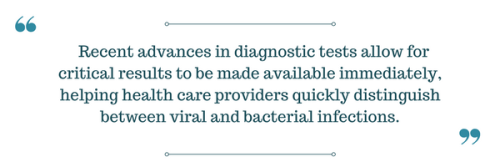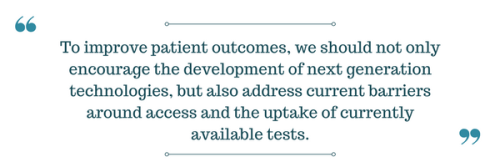Expert Spotlight: Five Questions with Tharini Sathiamoorthy of AdvaMedDx
With CDC’s Antibiotic Awareness Week (formerly Get Smart Week) and the World Health Organization World Antibiotic Awareness Week, November is unofficially the month of raising awareness about antibiotic resistance. This is a great opportunity to highlight the many ways we can help tackle antibiotic resistance. One such way is by utilizing diagnostic tests, a test ordered by healthcare professionals to help determine what’s making a person sick. Diagnostic tests are a critical component in any strategy to reduce antibiotic resistance as they can help clinicians decide whether an antibiotic will cure an infection and which specific drug will work best.
ARAC has partnered with AdvaMedDx, an organization representing the diagnostic community, to highlight the need for the better use of, and investments in, diagnostic tests to help reduce unnecessary antibiotic prescriptions. We’ve asked Tharini Sathiamoorthy, Associate Vice President of AdvaMedDx to answer some important questions about diagnostics.
1. Will you tell us a little about AdvaMedDx and how your organization was founded and what your central mission is?
AdvaMedDx is a division of AdvaMed, the Advanced Medical Technology Association, which advocates for the power of medical diagnostic tests to promote wellness, improve patient outcomes, and advance public health in the United States and abroad.
AdvaMedDx member companies produce innovative, safe and effective diagnostic tests that are performed in laboratories, at the hospital bedside, in doctor's offices, in medical clinics, and in the home. The association advocates for health care policies that support diagnostic tests through robust innovation, timely regulatory approval, appropriate payer coverage, payment rates commensurate with impact on care, and rapid adoption of new, safe, and effective diagnostic tests.
2. Diagnostic tests are a critical component in any strategy to reduce antibiotic resistance because they take the guesswork out of medicine. Do you think healthcare providers currently are utilizing existing diagnostic tests to their full potential? Why or why not?
Infectious bacteria that are impervious to antibiotics are increasingly a global threat, with a substantial impact on patients, health care systems and economies worldwide. Current trends project antibiotic resistance could cause up to 10 million deaths annually by 2050.
Antibiotics are one of the world’s greatest advances in health care, providing effective, life-saving treatments for infections that throughout human history have been often fatal or debilitating, including strep throat, bacterial meningitis, ear infections, tuberculosis, whooping cough, and pneumonia. However, widespread and sometimes indiscriminate use of antibiotics is driving the prevalence and spread of bacteria that are resistant to many or all of the antibiotics currently available.
There are several ways that health care providers can help to preserve the efficacy of antibiotics, including talking to laboratories to determine what diagnostic tests are available in their office or hospital and turn-around time of results; using diagnostic tests to inform treatment decisions, prescribing practices, and guide infection control decisions; and finally explaining to patients the importance of only taking an antibiotic when absolutely necessary.
3. Rapid infectious disease diagnostics have been heralded as the cornerstones to a new era in antibiotic stewardship. Why is this?
Diagnostics play a pivotal role in fighting infectious diseases, and test manufacturers are continually advancing and developing diagnostics to match the evolution and emergence of new infectious diseases.
Recent advances in diagnostic tests allow for critical results to be made available immediately, helping health care providers quickly distinguish between viral and bacterial infections. Patients can be tested at the point of care to determine the appropriate treatment strategy at an earlier stage – for example, bacterial infections require treatment with antibiotics, but viral infections do not.
Additionally, innovative diagnostic tests can help prevent antibiotic resistance and improve the careful use of medicine, especially where they are often overused – in outpatient or point-of-care settings. Proper use of diagnostic tests leads to physicians appropriately administering antibiotics, which reduces potential misuse. All of this improves patient outcomes while lowering associated health care costs.
4. We’ve heard anecdotally from healthcare providers that insurance companies too often don’t want to pay for diagnostic test or don’t want to pay a fair reimbursement cost. Why is this and how does this impact companies selling and/or inventing diagnostic tests?
While diagnostic tests play an essential role in providing quality care and improving patient outcomes, health care systems and insurers often undervalue their importance. Therefore, these tests may seem expensive or burdensome when compared to prescribing antibiotics. However, using diagnostic tests may actually be less expensive when compared to the costs of infections, hospitalizations, readmission and long-term impacts of antibiotic resistance.
Part of what’s driving reimbursement issues is that some insurers are adopting new provider payment models – including pay-for-performance and financial risk-sharing arrangements – along with cumbersome coding regimes and rate setting processes that may disregard the value of tests. These approaches emphasize cost reduction, which may discourage providers from using new tests that can bring value to patients and the health care system, but add to near-term costs.
Reimbursement challenges can create difficult hurdles and dampen the incentive for new test development. To address this issue, AdvaMedDx is seeking payment reform and Medicare fee schedule modernization that recognizes the full contribution of diagnostic tests in health care.
It’s also important to understand what true value diagnostic tests bring to encourage wider spread adoption and reimbursement. That’s why AdvaMedDx is leading a global initiative with more than 30 companies and organizations to educate stakeholders about the importance of diagnostic tests and to optimize the use of these tests to fight antibiotic resistance.
5. We hear a lot of people calling for more investments in discovering new antibiotics, while this is important we think it is equally important that we invest in new diagnostic tests. Are there enough people, governments and companies investing in new diagnostic tests? Why or why not?
There are more than 4,000 different diagnostic tests available today in the United States. However, they remain a lesser known or used tool for medical professionals despite their proven value. To improve patient outcomes, we should not only encourage the development of next generation technologies, but also address current barriers around access and the uptake of currently available tests.
AdvaMedDx’s global stakeholder initiative on diagnostic tests to fight against antibiotic resistance is based on a stakeholder statement of commitment. It serves as a framework for collaborative action, outlining specific goals for leveraging existing diagnostic solutions and investing in improvements and access. We hope this effort will help to reduce the threat of antibiotic resistance and improve the quality of care for affected patients around the world.




